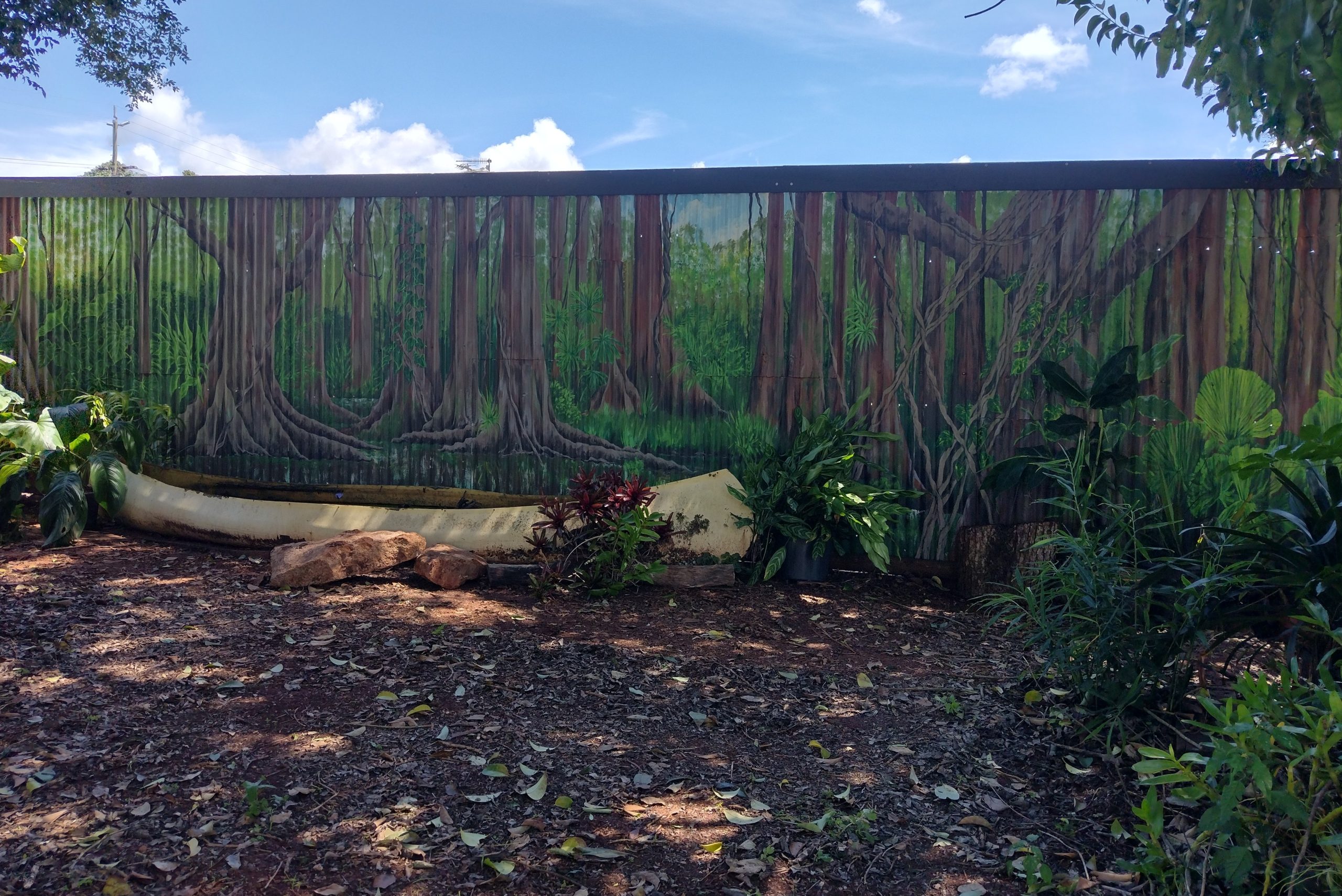The things I get up to when I’m not leading holidays!
The brief sounded reasonable enough: paint a mural onto a garden fence. It was right up my street – the project, that is. The location was Tolga, in the Atherton Tablelands, northern Queensland.
It was rather a large fence, long and relatively low, which had been erected when a neighbour had chopped down some trees, eliminating at once privacy, shade and aesthetics. Somehow, these things had to be replicated. A forest, realistic enough to step into, would do the trick.
Never being one to shirk a challenge, I accepted with genuine enthusiasm, before I visited the site and realised that the surface of the ‘fence’ was deeply corrugated. The full severity of this handicap only became evident with the first brush stroke.
‘Limited palette’ takes on a whole new meaning when using outdoor, weatherproof, semi-sheen colours which don’t necessarily mix in a way you’d expect, nor do they dry the colour they appear on the chart. I insisted on a bright yellow; a blue, and a dark, forest green be added to the collection of vivid test-pots accrued over the years, lurking on dusty shelves in the shed. I was supplied with a variety of used decorators’ brushes, rags and a trestle table upon which I lined up all the colours and empty yoghurt pots for mixing. In view of the forecast, Pete erected a nifty, though flimsy, waterproof gazebo for the occasional torrential downpour, which eventually contorted itself into a broken, sodden mangle across my table during an overnight storm.
I had a week: I needed to get used to some uncharacteristically early starts.
Stage 1
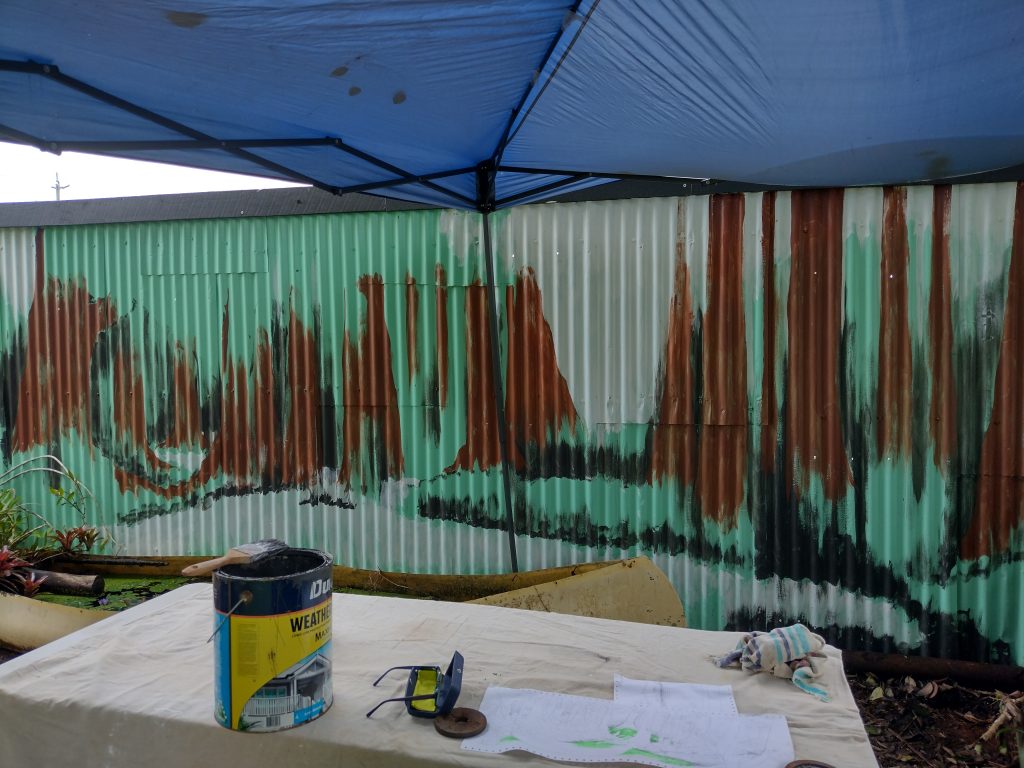
Like an abstract painter faced with an empty canvas, I suppose, I had little idea of what I was doing until I placed the first mark. I’d made a rough sketch, but the scale was all wrong so there was little to be gained from looking at it. Here, I was trying to figure out where to place a creek. An old canoe, come to rest at the foot of the fence, was filled with water; lotus, green weed and tadpoles had now taken up residence. Not only was it immoveable and extremely awkward to paint around, but the idea was for it to become a part of the picture, as if it had come to rest on the shores of a waterway. I liked the mystery. Where had the inhabitants gone? It was obviously long abandoned; had the paddlers perished, or simply obeyed a call to disappear into the trees, never to return? Perhaps the boat had sprung a leak, and they had simply walked home. I favour the idea they’re living free, unseen. My problem remained, though, of how to paint it.
I wanted a little light in the sky. Although we wouldn’t be seeing the tops of the trees, there would be little glimpses of sky through the canopy here and there. If I placed it above the creek, I’d be able to use some pale colours in the water, which I was already concerned about portraying convincingly.
The limitations of the surface were immediately obvious: it was impossible to use horizontal brush strokes, which one would normally do for calm water. Making the distinction between water and vegetation without variation in strokes was going to be tricky.
I started placing random upright tree trunks, trying to get a feel for how it was all going to work in terms of composition, scale and tone. The configuration lent itself to trees, which was some consolation.
Note the pool of water which has gathered in the roof of my ‘shelter’ during the night!
Stage 2
Pouring six or seven different greens and some bright yellow into a roller tray and utilising a piece of bathroom sponge, I attempted to represent the leafy understory. This should have been simple enough after all my sponging practice at the pottery but again, the dreaded corrugation, along with the paint drying out quickly despite the humidity, added to my frustration.
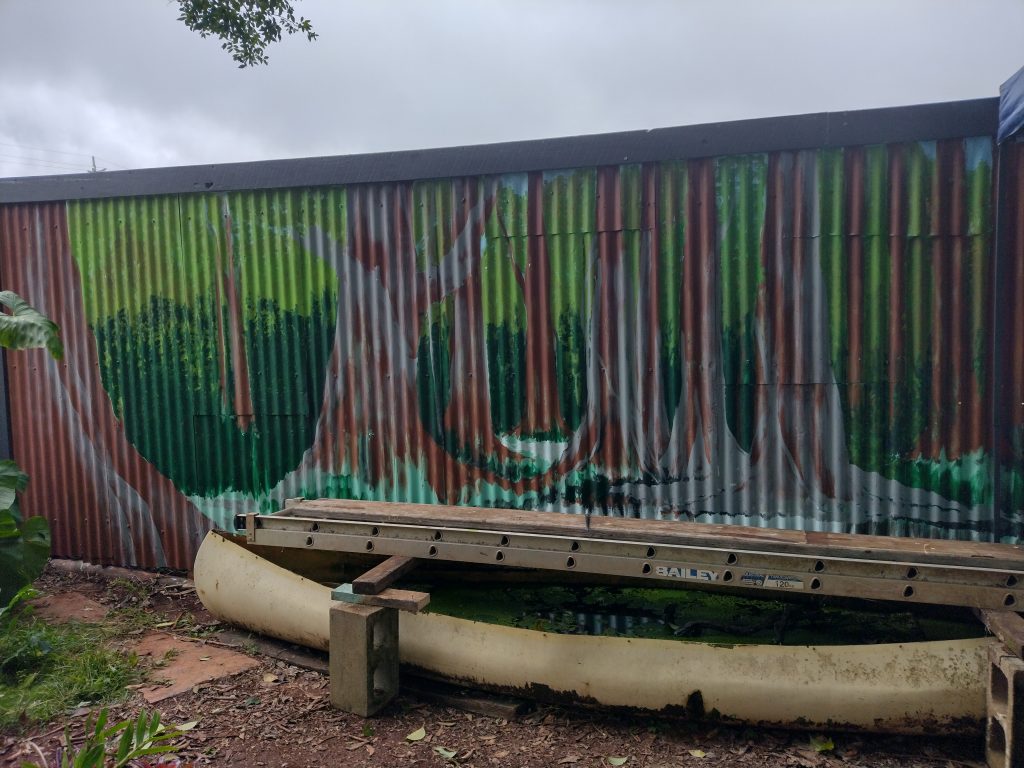
Despite the myriad colours, it was now looking rather flat, so I tried to add some lighter tones to the tree trunks, and to grey it up a bit, as it was too red-brown. Things began to show more promise once some form started to emerge, but the colour still wasn’t right.
I mixed a different pale brown to cover most of the grey, although I left little bits poking through here and there to denote rough patches on the bark. I also left tiny areas of the original turquoise background colour showing under some dry brush strokes, suggesting lichen. These were, accidentally, some of my favourite parts.
Once I was happier with the tree colour I began to add some creepers and to pick out more detail.
At this stage I also sponged more white into the top of the canopy as it was too solid-looking. The sponge worked pretty well for little glimmers of light and tiny, distant leaves.
Stage 3
Using existing potted plants which had been sitting up against the fence before being moved out of my way, I began to outline some leaves in the areas where the plants would eventually live. The idea was that the painted leaves would be a ‘background’ to the real ones, almost a shadow, creating a 3D effect. For other rainforest leaves I had a couple of sketches and some very badly-printed photographs, but I mostly relied on familiarity with what I’d been walking amongst during my weeks in Queensland. I tried to include only vegetation I was sure I’d seen in the Tablelands.
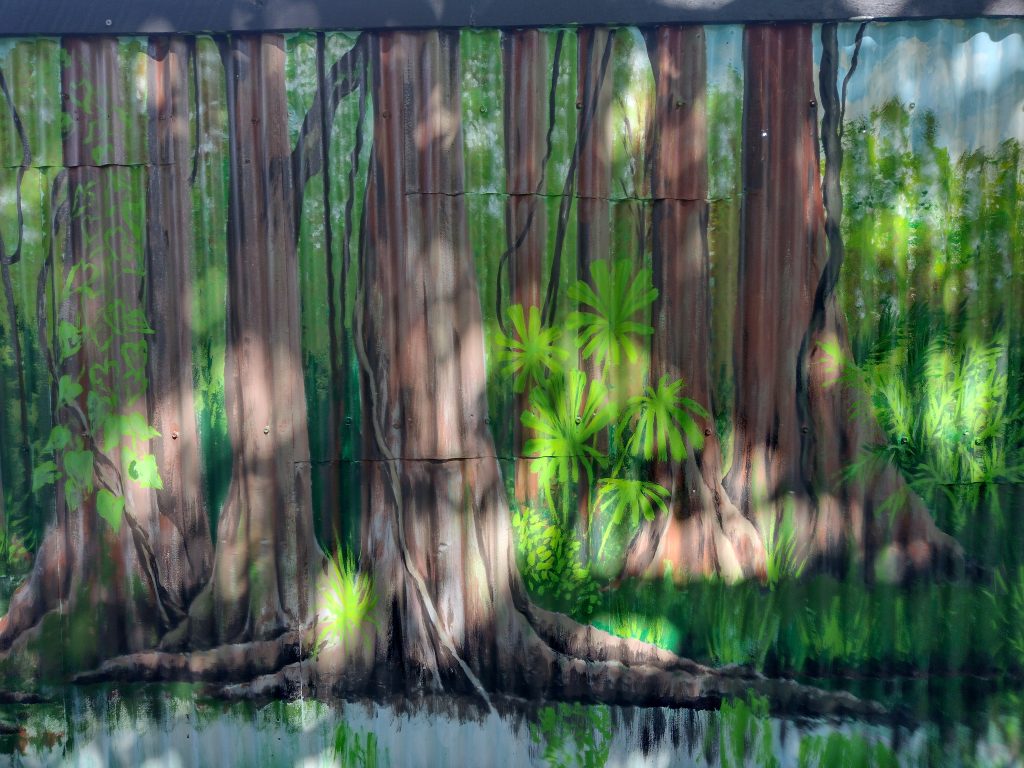
I soon learned that the mural was bathed in sunlight early each morning, and that if I made sure I painted the light from the correct direction, it really looked like sun on trees, rather than sun on a painted fence.
I added highlights and lowlights by mixing a paint as dark as I could without using an actual black, which would flatten everything.
I began to return the plants to their rightful places, checking and finishing the leaves ‘behind’ them. I wasn’t very happy with the variegated vines on the trunks, but they were improved by adding a suggestion of shadow under each one. Tone, tone, tone.
Stage 4
Finally, I was able to remove the cleverly designed ladder and wood contraption I had stood on to reach the top of the fence above the canoe. I could now get the brush low enough to paint the creek, squeezing my hand all the way down to the bottom. As I could only use up-and-down strokes, the easiest solution was to depict the water by the reflections in it. It couldn’t be a mirror-image, though, because creeks are murky and dank!
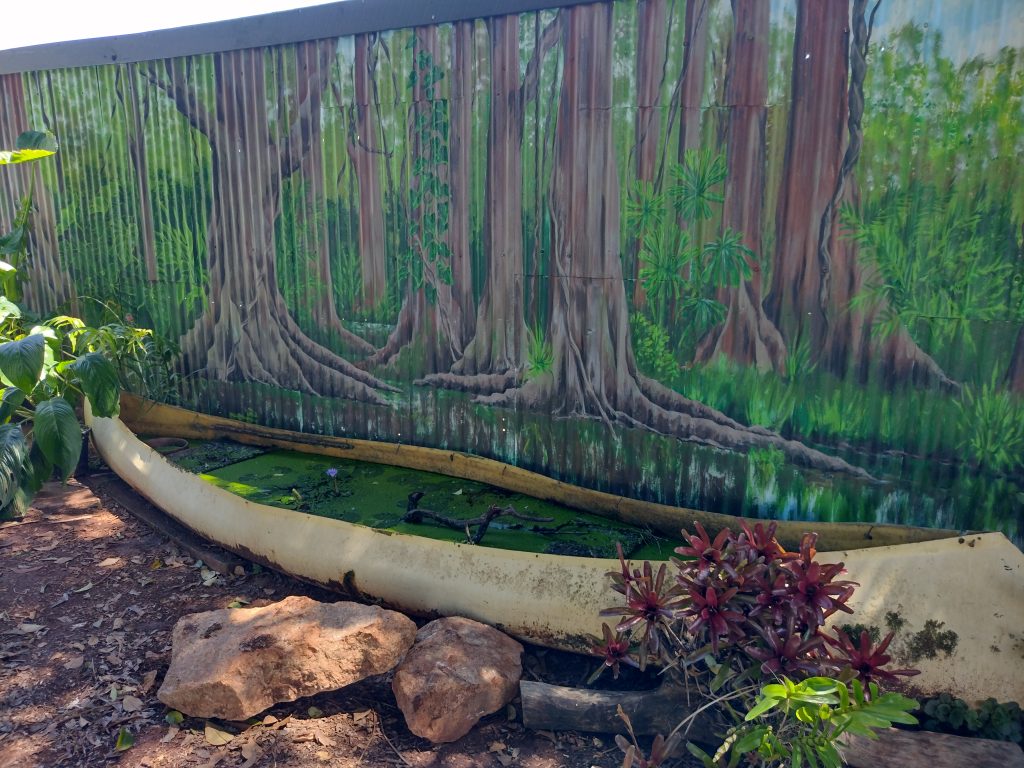
I left this part for the end, because I needed the ladder until the last minute, but mostly because I was unsure how I was going to tackle it. After tidying up the ‘shoreline’ and adding a bit of light on the tiny, glimpsed areas of water, I decided I’d got away with it. In fact, it’s what I was most proud of, in the end.
Stage 5
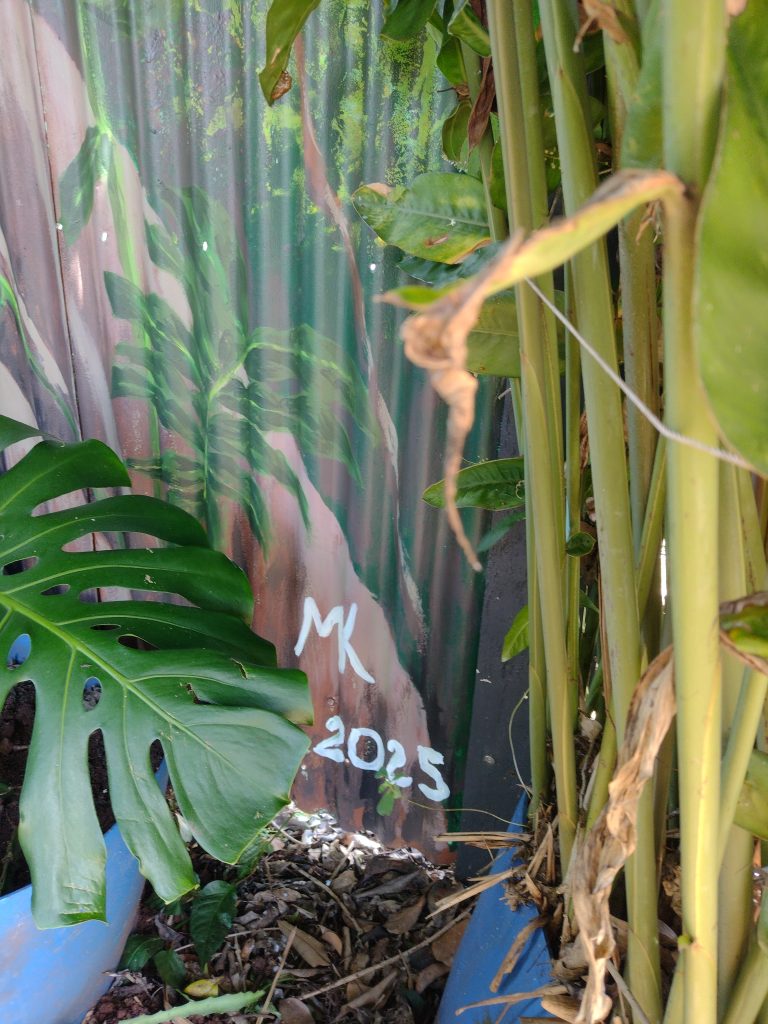
The most important part:
Sign it and date it, then show it to the customer. He appeared to be delighted with it.
Phew!
